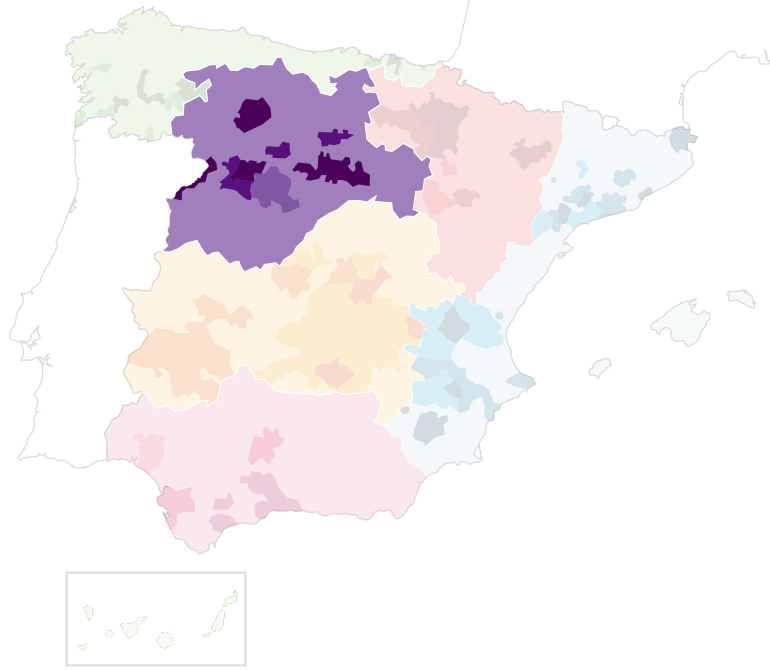The Control Board of the Arribes Designation of Origin was recognised on 27 July 2007.
You are here

Duero River Valley
Castilla y León is the political name of this area, but most of the greatest wines are from vineyards around the Duero River. Indeed Spain’s most famed winery, Vega Sicilia, anchors the DO known as Ribera del Duero (meaning, the “banks of the River Duero”), fueled by the ubiquitous Tempranillo grape, Spain’s most planted red. The Duero River travels 460 miles from high in the Sistema Ibérico, forms part of the border between Spain and Portugal and then empties into the Atlantic at Oporto, a town that gives its name to a famous Portuguese fortified wine.
The table wines grown along its banks are nearly as intense as Port but are far more practical at the table. Roasted lamb and goat are genius here, and the cold Atlantic seems far away in climate and cuisine.This is high elevation viticulture: days are warm or even hot; nights are cold. Ripening is slowed; the wines become rich and ripe but hang on to their dusty, astringent structure. The less expensive wines are for immediate, delicious drinking; the top wines (Vega Sicilia, Pingus, Pesquera and many others) can last decades.
Arlanza is located in the provinces of Burgos and Palencia, Castile and Leon, Spain. The DO takes its name from the river Arlanza which flows through it.
The first written evidence of wine production in this area comes from the 12th century, when the monastery of Santa María de Bujedo de Juarros purchased vineyards on the banks of the rivers Arlanza and Duero.
The valleys and terraces of the Douro River on the border with Portugal are home to this winegrowing area, which includes 47 towns and villages from the provinces of Zamora and Salamanca.
Bierzo is located in the northeast of the region of Castilla and Leon; specifically in the province of Leon. It borders both Galicia and Asturias, with the northeastern delimitation bordering the provinces of Orense and Lugo, and with Asturias to the north.
Geographically, the zone is ideally located between the coast and the interior, which has motivated the settlement of various towns and civilizations throughout history. The vineyards are strategically placed on terraces of relatively low inclination next to the rivers, on hillsides and on pronounced inclinations with an average height of between 450 and 1.000 meters. The semi humid climate and mild temperatures are prime for grapevine growing.
Cigales has always been associated with aromatic & rosé wines. But once the area was granted DO status, producers began to show an interest in making red wines as well, following the example of other Duero valley DOs, and, above all, given the enormous potential of the region's reigning variety, Tempranillo, also known here as Tinta del País.
Certainly, the soil, climate and grapes of this small growing area (still less than 3,000 hectares) as well as the first results attained by the bodegas, promise well for the future. In fact, the DO Regulatory Council is presently drafting new regulations that will include other varieties - Cabernet Sauvignon and Merlot for reds, and Sauvignon Blanc for rosés - to enhance the wines.
The Ribera del Duero is blessed by a combination of terroir, microclimate and a native grape that gives superb, complex red wines.
At this altitude Tempranillo (also known as Tinta del País or Tinto Fino) gives thin-skinned and refreshingly acid fruit, which in turn gives wines that are delicious when they are young but also have the capacity to age into magnficent Gran Reservas.
The Denomination of Origin Rueda was approved by the Ministry of Agriculture on January 12, 1980; it was the first Denomination of Origin to be approved in the Region of Castilla y León, after years of hard work in order to earn acknowledgement and protection for its autochthonous grape variety: the Verdejo.
The Denomination of Origin Rueda possesses exceptional natural resources for the production of top-quality wines. Specialised in making internationally renowned white wines. Also, from the 5 of August of 2008 the red wines and rosé are protected by the Denomination of Origin Rueda.
Tierra de León Protected Designation of Origin born on July of 2007, but the existence of a characteristic grape and wines variety in this area comes to the Roman Era, lots of centuries ago.
The production area, with 1,413 Ha, is situated on the south of León and part of the north of Valladolid provinces. It is under the influence of Esla and Cea riverside.
The region known as “Tierra del Vino” – or “the land of wine” – is located in Castile-León , at the southeast of the province of Zamora. It lies on both banks of the Duero river.
It covers a total surface area of 1,799 square kilometers, which extends throughout a total of 56 boroughs, 46 of which belong to the province of Zamora and 10 more to the province of Salamanca.
As a historic winemaking area Toro has made a huge comeback in the last twenty years. Its rich, ripe and powerful red wines, based on the native Tinta de Toro grape, began to show their potential after a new generation of trained oenologists began work here and the necessary investment was made in stainless steel equipment.
There has also been a continuous upgrading of harvesting methods in the last decade. Its evolution over recent decades has placed this wine as protagonist of the magma of wine reviews at both national and international levels.








